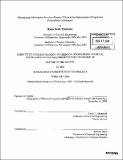| dc.contributor.advisor | Paula T. Hammond. | en_US |
| dc.contributor.author | Waletzko, Ryan Scott | en_US |
| dc.contributor.other | Massachusetts Institute of Technology. Dept. of Chemical Engineering. | en_US |
| dc.date.accessioned | 2009-08-26T17:17:44Z | |
| dc.date.available | 2009-08-26T17:17:44Z | |
| dc.date.copyright | 2009 | en_US |
| dc.date.issued | 2009 | en_US |
| dc.identifier.uri | http://hdl.handle.net/1721.1/46671 | |
| dc.description | Thesis (Ph. D.)--Massachusetts Institute of Technology, Dept. of Chemical Engineering, 2009. | en_US |
| dc.description | Includes bibliographical references. | en_US |
| dc.description.abstract | Liquid Crystalline Elastomer (LCE)-inspired segmented polyurethane elastomers possessing widely different extents of ordering were created to mimic the hierarchical structure of the continuous matrix and superior mechanical performance of spider silk fibers. The silk's remarkable toughness originates from a fiber morphology that possesses [beta]-pleated crystalline sheets within an amorphous matrix. In the polyurethane materials, various extents of poly(ethylene oxide) (PEO) soft segment ordering were implemented within continuous soft domains that were connected by hexamethylene diisocyanate-butanediol (HDI-BDO) hard segments. Soft segment crystallinity studies revealed the need to optimize the extent of continuous soft domain ordering. Highly crystalline PEO soft segments, while they display good microphase segregation properties, sacrifice extensibility due to their high melting transition temperature. Moderately crystalline PEO soft segments, meanwhile, possess less defined phase segregation but enhanced mechanical properties from their reversible dispersed crystalline soft segment domains. Non-crystalline Pluronic copolymer systems had good mechanical properties that resulted from both a strong hard segment incompatibility and a highly mobile soft segment matrix. Hydrogen-bonded hard domain shearing during in-situ tensile deformation yields oriented hard blocks that align at a preferred tilt angle of ±60° from the strain direction. Extensive alignment and orientation of the moderately-ordered PEO soft segments occurred during deformation, which was consistent with its observed mechanical behavior. Pluronic-containing segmented polyurethanes formed an ordered mesophase in the continuous soft matrix during deformation. A series of cyclic, aliphatic polyurethanes with dicyclohexyl methane diisocyanate (HMDI) hard segments and poly(tetramethylene oxide) (PTMO) soft segments was synthesized to study compositional effects on the extent of soft segment mixing, and how these effects translated to both mechanical and barrier performance. Shorter soft segment chain systems displayed a greater hard segment compatibility, which resulted in materials that were both more rigid mechanically and provided better barrier characteristics. | en_US |
| dc.description.abstract | (cont.) Longer soft segments in the continuous polymer matrix displayed a more phase segregated structure, which enhanced their mechanical properties but sacrificed barrier effectiveness. Incorporation of dimethyl propane diol (DMPD), a branched chain extender, created a completely amorphous polyurethane matrix. Polyurethane/Laponite nanocomposites were also created using particles that were capable of preferentially associating with hard or soft segments. HMDI-BDO-PTMO polyurethane/Laponite nanocomposites demonstrated drastically reduced mechanical performance (~13-fold decrease in toughness and ~10-fold decrease in extensibility). The deteriorated mechanical performance was attributed to the formation of an interconnected hard segment continuous morphology that significantly reduced matrix extensibility. HMDI-DMPDPTMO polyurethane/Laponite composites, on the other hand, only experienced modest reductions in extensibility (-70% of total initial extensibility) while maintaining toughess and increasing initial modulus 10-fold. Mechanical behavior resulted from well-dispersed Laponite clay platelets that reinforced the amorphous polymer matrix while imposing modest chain segmental mobility restrictions. | en_US |
| dc.description.statementofresponsibility | by Ryan Scott Waletzko. | en_US |
| dc.format.extent | 157 p. | en_US |
| dc.language.iso | eng | en_US |
| dc.publisher | Massachusetts Institute of Technology | en_US |
| dc.rights | M.I.T. theses are protected by
copyright. They may be viewed from this source for any purpose, but
reproduction or distribution in any format is prohibited without written
permission. See provided URL for inquiries about permission. | en_US |
| dc.rights.uri | http://dspace.mit.edu/handle/1721.1/7582 | en_US |
| dc.subject | Chemical Engineering. | en_US |
| dc.title | Determining soft segment structure-property effects in the enhancement of segmented polyurethane performance | en_US |
| dc.type | Thesis | en_US |
| dc.description.degree | Ph.D. | en_US |
| dc.contributor.department | Massachusetts Institute of Technology. Department of Chemical Engineering | |
| dc.identifier.oclc | 428093269 | en_US |
